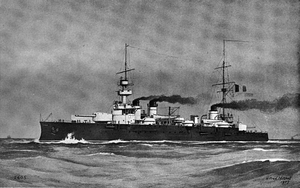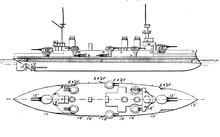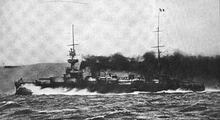French battleship République
 Illustration of République | |
| Career (France) | |
|---|---|
| Name: | République |
| Namesake: | French Republic |
| Laid down: | December 1901 |
| Launched: | 4 September 1902 |
| Commissioned: | December 1906 |
| Struck: | 1921 |
| General characteristics | |
| Class and type: | République-class pre-dreadnought battleship |
| Displacement: | 14,605 t (14,374 long tons; 16,099 short tons) |
| Length: | 133.81 m (439.0 ft) pp |
| Beam: | 24.26 m (79.6 ft) |
| Draft: | 8.41 m (27.6 ft) |
| Propulsion: | 3 triple-expansion steam engines, 18,000 shp (13,000 kW) |
| Speed: | 19 knots (35 km/h) |
| Complement: | 766–825 |
| Armament: | 4 × 305 mm Modèle 1893/96 guns 18 × 164 mm Modèle 1896 guns |
| Armor: | Belt: 280 mm (11 in) Turrets: 350 mm (14 in) Conning tower: 305 mm (12.0 in) |
République was a pre-dreadnought battleship of the French Navy built in the early 1900s. The lead ship of her class, she had only one sister ship: Patrie. The ship was built by the Arsenal de Brest, laid down in December 1901, launched in September 1902, and commissioned into the fleet in December 1906, the same time as the revolutionary British battleship HMS Dreadnought. Armed with a main battery of four 305 mm (12.0 in) guns, she was outclassed by Dreadnought by the time she entered service.
République served in the Mediterranean Fleet for the duration of her career. In 1910 she was accidentally torpedoed by Patrie. She was moored near the battleship Liberté when the latter exploded accidentally in 1911, and was damaged by flying debris. After the outbreak of World War I in August 1914, she covered troop convoys from Algeria to France, and participated in the sinking of the Austro-Hungarian cruiser SMS Zenta later that month. She spent the majority of the war in Corfu at the mouth of the Adriatic Sea, to keep the Austro-Hungarian fleet bottled up in the Adriatic. She was eventually stricken in 1921 and broken up for scrap thereafter.
Design

République was laid down at the Arsenal de Brest in December 1901, launched on 4 September 1902, and completed in December 1906,[1] at the same time as the revolutionary British battleship HMS Dreadnought, which rendered the pre-dreadnoughts like République outdated.[2] The ship was 133.81 meters (439 ft 0 in) long between perpendiculars and had a beam of 24.26 m (79 ft 7 in) and a full-load draft of 8.41 m (27 ft 7 in). She displaced 14,605 metric tons (14,374 long tons; 16,099 short tons) at full load and had a crew of between 766 and 825 officers and enlisted men. She was powered by three vertical triple expansion engines with twenty-four Niclausse boilers. They were rated at 18,000 indicated horsepower (13,420 kW) and provided a top speed of 19 knots (35 km/h; 22 mph). Coal storage amounted to 1,800 t (1,770 long tons; 1,980 short tons).[1]
République 's main battery consisted of four Canon de 305 mm Modèle 1893/96 guns mounted in two twin gun turrets, one forward and one aft. The secondary battery consisted of eighteen Canon de 164 mm Modèle 1893 guns; twelve were mounted in twin turrets, and six in casemates in the hull. She also carried twenty-five 3-pounder guns. The ship was also armed with two 450 mm (17.7 in) torpedo tubes submerged in the hull. The ship's main belt was 280 mm (11.0 in) thick and the main battery was protected by up to 350 mm (13.8 in) of armor. The conning tower had 305 mm (12.0 in) thick sides.[1]
Service history
After commissioning in December 1906, République conducted her sea trials. During the speed trials, she reached a top speed of 19.15 knots (35.47 km/h; 22.04 mph), more than a knot faster than her contract speed of 18 knots (33 km/h; 21 mph).[3] In 1907, after joining the fleet, République took first place in the annual gunnery competition.[4] She was assigned to the 1st Division of the Mediterranean Fleet, along with her sister Patrie and Suffren, the divisional flagship.[5]
On 16 February 1910, during exercises in the Gulf of Jouan, a torpedo was accidentally launched from her sister ship Patrie. The torpedo struck République, damaging her hull.[6] On 25 September 1911, the battleship Liberté was moored near Republique in Toulon. An accidental explosion, the result of the spontaneous combustion of nitrocellulose gel, occurred aboard Liberté; she was destroyed and debris was hurled into the air.[1] République was hit by a 37-metric-ton (36-long-ton; 41-short-ton) piece of armor plate from Liberté, on the starboard quarter directly behind the main battery turret.[7]
At the outbreak of World War I in August 1914, République was assigned to the 1st Division of the 2nd Squadron in the Mediterranean, along with Patrie and the flagship, Vérité; this was the main battle fleet of the French Navy.[8] The French fleet was initially used to cover the movement of French troops—the XIX Corps—from Algeria to metropolitan France. As a result, the fleet was far out of position to catch the German battlecruiser SMS Goeben.[9] For the majority of the war, the French used their main fleet to keep the Austro-Hungarian fleet bottled up in the Adriatic Sea. In 1914 she participated in the Battle of Antivari, where the battle line caught the Austro-Hungarian cruiser SMS Zenta by surprise and sank her. The French battleships then bombarded Austrian fortifications at Cattaro in an attempt to draw out the Austro-Hungarian fleet, which refused to take the bait.[10]

The French operations in the area were hampered by a lack of a suitable base close to the mouth of the Adriatic; the British had given the French free access to Malta, but it was hundreds of miles away. The Austrians also possessed several submarines, one of which torpedoed the dreadnought Jean Bart in December 1914. The threat from underwater weapons greatly limited French naval activities in the Adriatic.[11] As the war progressed, the French eventually settled on Corfu as their primary naval base in the area.[12] Together with the pre-dreadnought Gaulois, the ship covered the Allied evacuation from Gallipoli in January 1916.[13]
Later in 1916, République, Patrie, and the surviving Liberté-class battleships supported Allied operations in Salonica and also detached landing parties to support the Allied attempt to force Greek acquiescence for those operations in Athens on 1 December. They spent the rest of the war at Salonica and Athens.[14] During the war, four of République 's 3-pounder guns were converted into anti-aircraft guns with new high-angle mounts.[1] After the end of the war, République was placed in reserve in 1919, along with Patrie.[14] She was disarmed the following year and subsequently stricken from the naval register in 1921 and broken up for scrap.[1]
Footnotes
- ↑ 1.0 1.1 1.2 1.3 1.4 1.5 Gardiner, p. 297
- ↑ Gardiner & Gray, p. 21
- ↑ Brassey, p. 21
- ↑ The Navy, p. 31
- ↑ Garbett, p. 729
- ↑ "Torpedoing report". The New York Times. 17 February 1910. Retrieved 13 July 2012.
- ↑ Alger, p. 1458
- ↑ Guernsey, p. 179
- ↑ Halpern (1995), pp. 55–56
- ↑ Halpern (2004), p. 4
- ↑ Halpern (2004), pp. 3–4
- ↑ Halpern (2004), p. 16
- ↑ Caresse, p. 132
- ↑ 14.0 14.1 Gille, pp. 112–113
References
- Alger, Philip R., ed. (March 1911). United States Naval Institute Proceedings (Annapolis, MD: US Naval Institute) 37. Missing or empty
|title=(help) - Brassey, Thomas A., ed. (1907). Brassey's Naval Annual (Portsmouth, UK: J. Griffin & Co.). Missing or empty
|title=(help) - Caresse, Phillippe (2012). "The Battleship Gaulois". In Jordan, John. Warship 2012. London: Conway. ISBN 978-1-84486-156-9.
- Garbett, H., ed. (March 1907). Journal of the Royal United Service Institution (London, UK: J. J. Keliher & Co) LI. Missing or empty
|title=(help) - Gardiner, Robert, ed. (1979). Conway's All the World's Fighting Ships 1860–1905. Greenwhich, UK: Conway Maritime Press. ISBN 978-0-8317-0302-8.
- Gardiner, Robert; Gray, Randal, eds. (1984). Conway's All the World's Fighting Ships: 1906–1922. Annapolis, MD: Naval Institute Press. ISBN 978-0-87021-907-8.
- Gille, Eric (1999). Cent ans de cuirassés français. Nantes: Marines. ISBN 2-909675-50-5.
- Guernsey, Irwin Scofield (1920). A Reference History of the War. New York, NY: Dodd, Mead & Co.
- Halpern, Paul G. (1995). A Naval History of World War I. Annapolis, MD: Naval Institute Press. ISBN 1-55750-352-4.
- Halpern, Paul G. (2004). The Battle of the Otranto Straits. Bloomington, IN: Indiana University Press. ISBN 978-0-253-34379-6.
- The Navy (Washington, DC: The Navy Publishing Co.) II. May 1908. Missing or empty
|title=(help)
| ||||||||||||||